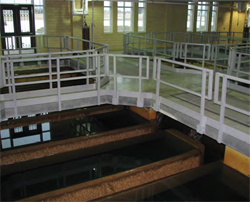Poison In The Water: How To Defeat Toxic Algae
By Christopher Mills, senior project manager, Hamilton Water and Quirien Muylwyk, technology manager for water, CH2M
Like many municipalities, Hamilton, Ontario, is wary of harmful algal blooms and toxic cyanobacteria. To mitigate the threat and protect drinking water, a proactive, risk-based plan was developed.
Heavy rains, environmental conditions, and nutrients from runoff have created favorable conditions in the Great Lakes to promote more frequent and longer occurrences of algal blooms. The nutrient-rich environment and warm temperatures of the Great Lakes make them the perfect incubator for algal blooms, some of which can be harmful. Algal blooms and cyanobacteria not only impact the aesthetic appearance, odor, and taste of water supplies, they also can be detrimental to public health and impact the normal operations of a water treatment plant, including loss of production capacity during high demand periods.
While several provinces and states are implementing long-term solutions to control the growth of algae, short-term solutions can minimize the impact of toxic algal blooms and avoid drastic measures like temporarily shutting off a community’s water supply. Proactive planning can identify the right mix of short- and long-term solutions to prevent contamination of treated water with algal toxins, while also improving the understanding of the risk posed by algae and cyanotoxins at the plant.
Located in the western end of Lake Ontario, five kilometers from the Burlington ship canal, the City of Hamilton’s Woodward Avenue Water Treatment Plant (WTP), a 900 MLD (238 MGD) facility, is a good example of a utility taking a proactive, riskbased approach to managing its algal toxin risks. The Woodward WTP treats water from Lake Ontario using conventional treatment with intake chlorination, coagulation with polyaluminium chloride filtration with granular activated carbon, and chloramination. Depending on conditions on the lake, the plant’s intake can be influenced by the water of the adjacent Hamilton Harbour, a water body in which cyanobacterial algal blooms have been observed due to its eutrophic conditions.
 Working with the City of Hamilton, CH2M conducted a study to assess the potential impacts of algae and cyanobacteria on the performance of the Woodward Avenue WTP, in terms of aesthetics, public health, and plant operations. Using a proactive approach to identify risks and recommendations for both short- and long-term control strategies, the study evaluated potential control strategies and emphasizes opportunities to leverage the existing treatment plant infrastructure to address raw water quality conditions and risks.
Working with the City of Hamilton, CH2M conducted a study to assess the potential impacts of algae and cyanobacteria on the performance of the Woodward Avenue WTP, in terms of aesthetics, public health, and plant operations. Using a proactive approach to identify risks and recommendations for both short- and long-term control strategies, the study evaluated potential control strategies and emphasizes opportunities to leverage the existing treatment plant infrastructure to address raw water quality conditions and risks.
Source Water Conditions
There are limited data available on the type and concentration of algae in the source water used by the Woodward Avenue WTP. However, monitoring data in the adjacent Hamilton Harbour are more prevalent than monitoring data in Lake Ontario.
Since 1987, the city has been reviewing water quality data in Hamilton Harbour. Long-term monitoring trends indicate an overall average increase in water transparency and a dramatic shift in algal community structure, with surface blooms becoming more frequent over the years. Also, after an approximately 10-year period of declining total phosphorus levels, there is a more recent trend of total phosphorus levels increasing. From analyzing and studying the water quality data, CH2M helped the City of Hamilton better understand the potential impacts and risks associated with algae, cyanobacteria, and their metabolites observed in the source water. Previously, the city had not utilized the data to holistically identify these trends over the years.
Based on the observed water quality trends in the source water, the study helped categorize the impact on water quality and the plant’s operational performance. It was determined that the predominant algal species in Hamilton Harbour had shifted towards noxious algal taxa (from chlorophytes and diatoms to cyanobacteria) over the past decade or longer. Per the literature, several species of cyanobacteria can produce algal metabolites that cause taste and odor (T&O) — specifically geosmin and MIB, which are responsible for the majority of reported T&O events — and/ or toxins. The study looked at water quality data from Hamilton Harbour as a worst-case scenario, and it was also confirmed that water exchange between Hamilton Harbour and western Lake Ontario does occur through the shipping canal, though water quality at the Woodward WTP intake is rarely influenced by this exchange. In some cases, however, algal species found in Hamilton Harbour were detected at the WTP intake, but at much lower levels. Therefore, because of the limited data available, it is difficult to draw conclusions about the linkage between water quality in Hamilton Harbour and western Lake Ontario, specifically at the Woodward WTP intake.
For this study, a conservative assumption was made that algal species present in Hamilton Harbour could potentially influence water quality at the Woodward WTP intake, as this represents a worst-case scenario and is consistent with the delineation of Hamilton Harbour as Intake Protection Zone 3 for the Woodward WTP. The approach taken to assess the risk was based on deducing trends in the raw water intake data, based on groups of algae and cyanobacteria as opposed to individual algal species.
Nevertheless, in order to mitigate risk using its existing infrastructure, CH2M utilized the city’s risk management framework tool to interpret data and identify the components needed for managing the issue. The city had used the tool for other projects, but using the riskmanagement tool to study water quality in relation to algal toxins was a new application for this tool.
Treatment Schemes
 Recommendations from the study included both short-term and longterm capital upgrades, monitoring practices, and operating strategies. Due to the size of the water body involved, there is no practical way to remove the risk in the source; therefore, a multibarrier approach is required to transfer and manage the city’s risk of algal events. Two areas where control can be provided include:
Recommendations from the study included both short-term and longterm capital upgrades, monitoring practices, and operating strategies. Due to the size of the water body involved, there is no practical way to remove the risk in the source; therefore, a multibarrier approach is required to transfer and manage the city’s risk of algal events. Two areas where control can be provided include:
- Raw water intake — removal of algae and cyanobacteria from the raw water (intact cells), as well as any algal metabolites (intracellular material) present in the raw water;
- Treatment processes — removal of algae and cyanobacteria (intact cells), as well as any remaining metabolites (such as T&O compounds and cyanotoxins) present in the treatment process, from either the source water or from cells ruptured as a result of treatment.
A multibarrier approach is necessary to physically remove intact cells (algae and cyanobacteria) before they rupture in the treatment process and remove dissolved metabolites through oxidation and adsorption. Under the multibarrier treatment approach, the inclusion of an oxidation step is implied. To manage the risks and benefits of raw water oxidation of the algae, cyanobacteria and their metabolites, a postfilter disinfection approach must be employed.
Taking this approach into consideration, the city has several options available to use and/or modify its existing infrastructure to mitigate the risk of algae and cyanobacteria, including:
- Raw water intake prechlorination modifications to the dose
- Pretreatment modifications to operate with a higher coagulant dose, apply a polymer as a coagulant aid during algal events, or apply a powered activated carbon seasonally during algal events
- Filtration modifications to promote adsorption in the granular activated carbon filters; this may impact the frequency of the GAC (granular activated carbon) replacement. (The WTP had taken proactive steps following a 1999 taste and odor event on Lake Ontario to protect itself from water quality impairments by replacing the media in its filters with GAC and adopting a media replacement schedule of four to five years.)
- Filtration modifications to reduce chlorine residual in both filter influent and backwash water to promote biological activity
- Increase chlorine contact time to provide all primary disinfection needs downstream of the filters; alternatively, install UV downstream of the filters.
- Shut down the WTP for 12 to 24 hours during algal events to reduce the volume of water that passes through the treatment process and into the distribution system, and supply water using system storage.
Future Risk
The above list identifies the short-term solutions that the City of Hamilton can implement to manage risks associated with algae and cyanobacteria. The long-term solutions such as adding new oxidation processes to destroy toxins, new pretreatment processes to remove algae, and extending the intake pipelines deeper into Lake Ontario could not be justified for implementation at this time based on the current understanding of the risks using the available data. In the future, the City of Hamilton will continue to monitor the source water to confirm the prolonged risk profile to determine if the city should invest in the longer-term solutions for managing algae and cyanobacteria risks. In the near term, by modifying its existing infrastructure, the city is adequately managing related risks. While these solutions could impact the plant’s operations, the plant currently has a surplus capacity and large reservoir storage capability. To determine the need for the higher-cost long-term solutions, the city will need to collect and analyze more water samples to confirm the raw water quality at the intake.
The City of Hamilton is leading the industry by implementing a proactive approach to monitoring algal blooms, ensuring residents continue to have access to a safe drinking water supply. In addition to reviewing and planning for algae risk and control needs, Hamilton is currently undergoing an overall study of its facility, closely examining plant performance and production, which enables the city to be pragmatic with recommended upgrades and take a multipurpose, holistic approach to managing its overall risk.
About The Authors
 Christopher A. Mills, PE, is a senior project manager at Hamilton Water for the City of Hamilton, Ontario. For nearly 20 years, his career has focused on municipal water and wastewater infrastructure, best practices, and system efficiencies. Mills received his B.E.Sc., Chemical and Biochemical Engineering, from The University of Western Ontario.
Christopher A. Mills, PE, is a senior project manager at Hamilton Water for the City of Hamilton, Ontario. For nearly 20 years, his career has focused on municipal water and wastewater infrastructure, best practices, and system efficiencies. Mills received his B.E.Sc., Chemical and Biochemical Engineering, from The University of Western Ontario.
Quirien Muylwyk is CH2M’s Technology Manager for Water in Canada. She has more than 20 years of experience in municipal water treatment and process engineering. Over the years, she has worked with owners and stakeholders on the strategic planning of plant upgrades, expansion projects, regulatory compliance needs, and optimization/operation of large plants. Muylwyk is active with the AWWA and serves as Chair of the Water Quality and Technology Division.
